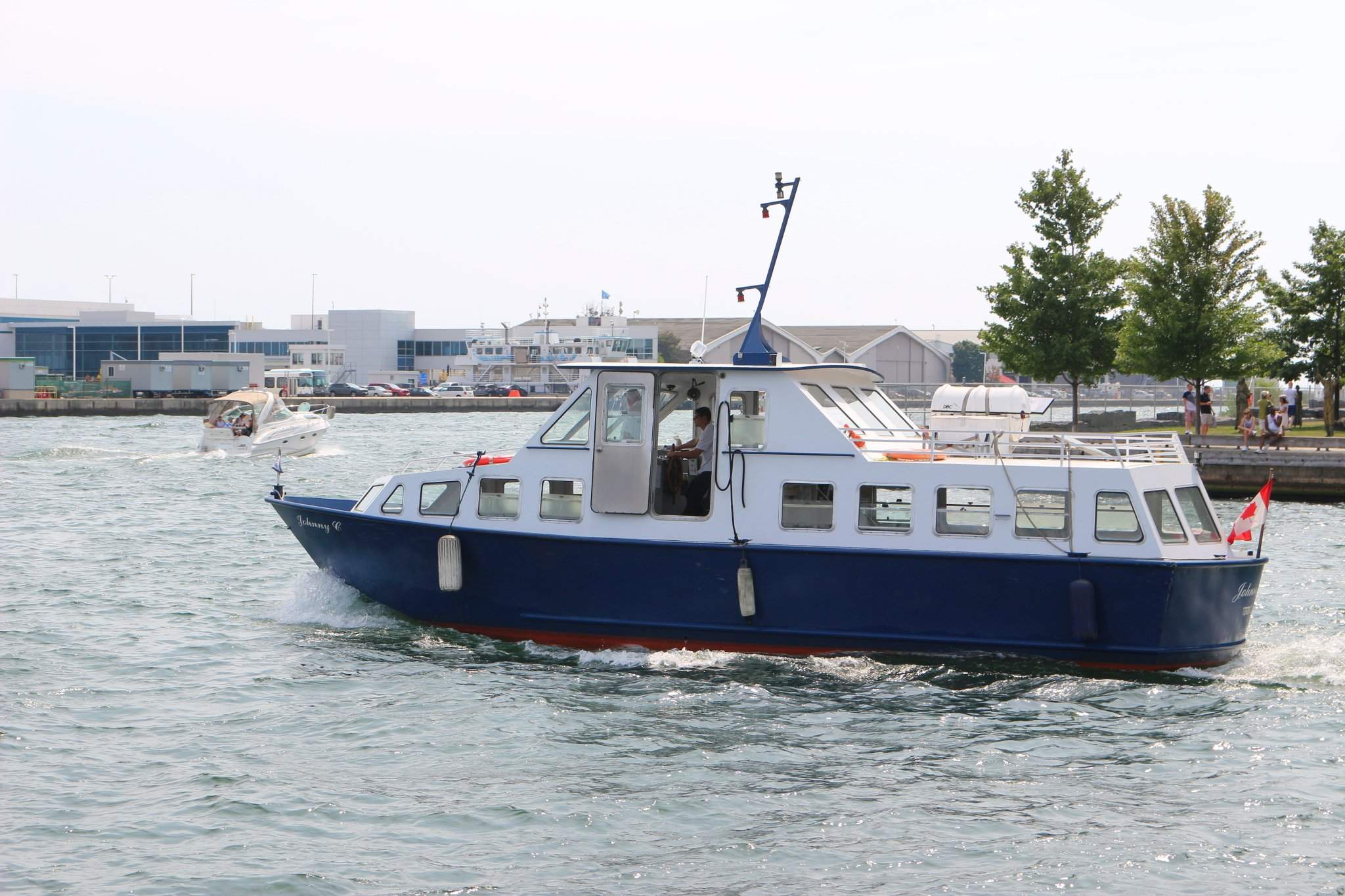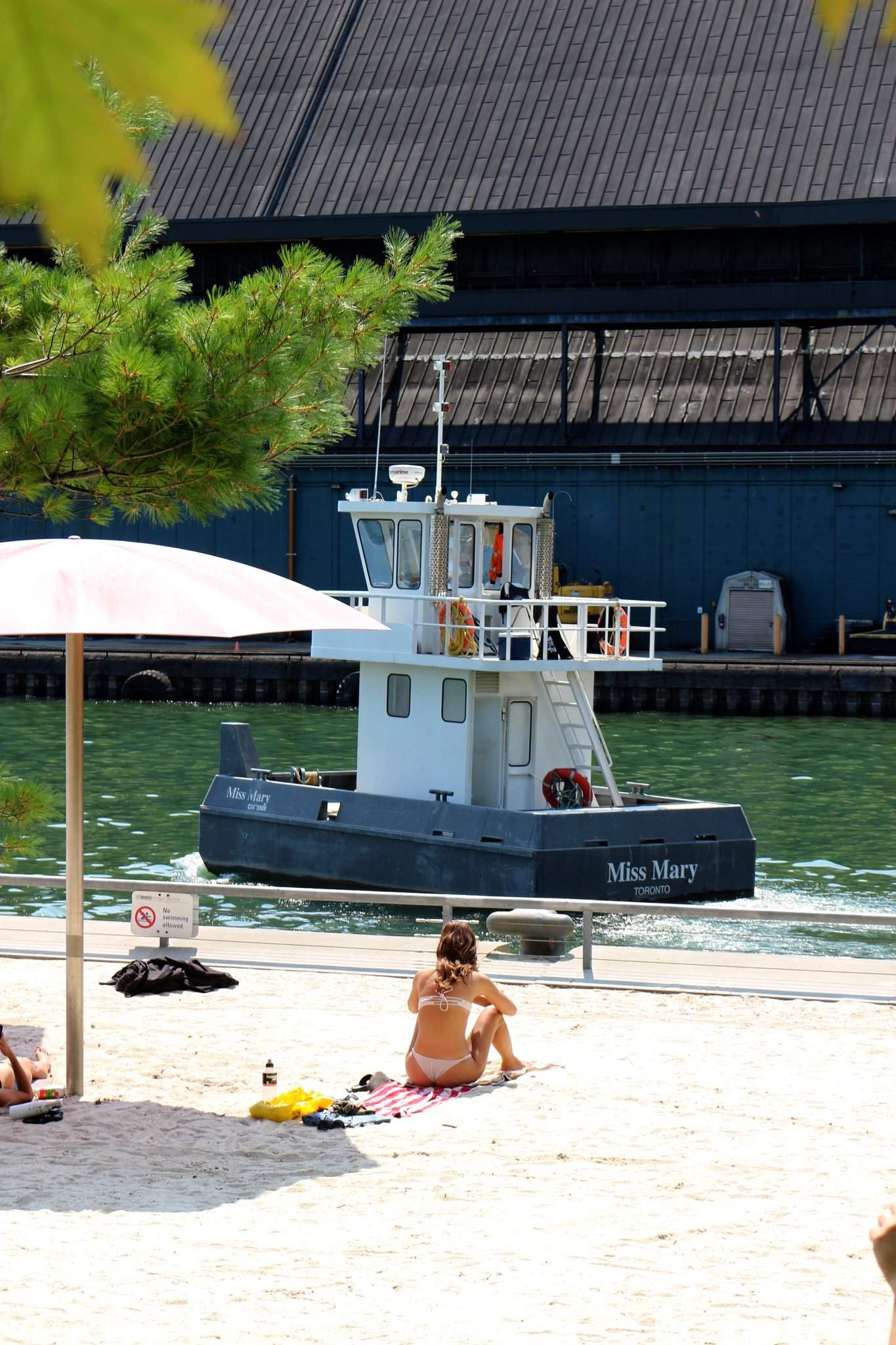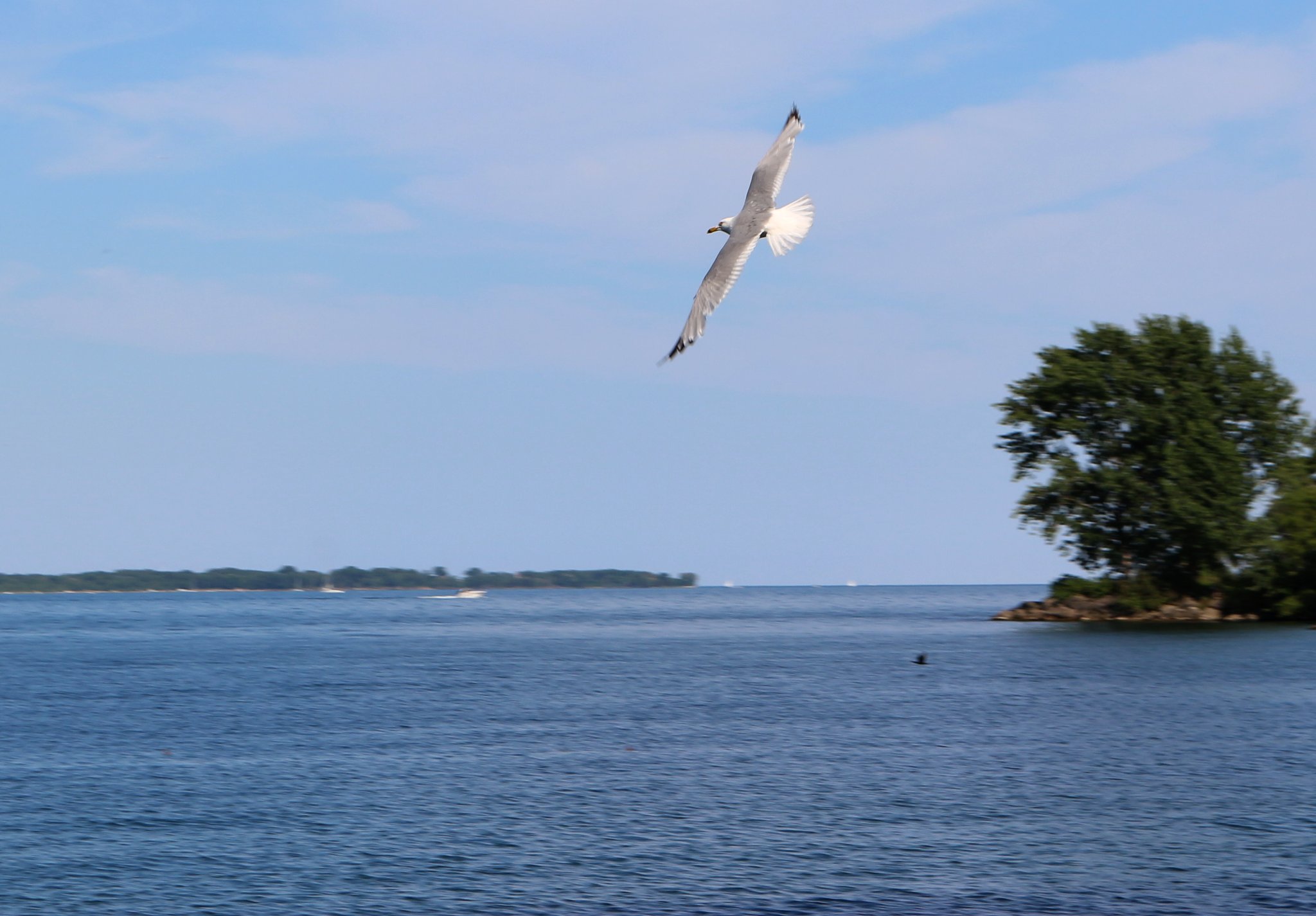Toronto is hardly alone even in North America, for being based around a fantastic natural harbour, which was once very important to industry along the waterfront, and is now used mostly by pleasure-craft.
But that change long since established, it’s civilian tone has since shifted much slower than many hoped. Numerous excellent improvements have been accomplished, adding greatly to the already fine waterfront parks, but many projects and areas remain frustratingly frozen by too many competing interests, to ever make even very obvious progress.
These historic silos in the background of the spry Johnny C, are an example of a great opportunity that was totally blown by this paralysis. Now crumbing so dangerously they’ve been fenced off, to keep joggers from being clobbered by falling chunks of concrete, there was once a fantastic plan to turn this into a music centre for the whole city – including recording studios, performance spaces, and label offices – many Canadian music notables were behind it – Panasonic even offered the project corporate backing.
A flagship centre would be a great thing for Toronto music – Metronome – was the working name of the proposal (I still have a hat, given to me by John Harris, who suggested the whole thing). And to prove the viability – some very fine architecture has been created out of silos of this very type, elsewhere.
At some point, we Canucks – Torontonians especially, need to work up a bit more entrepreneurial yes-energy for ourselves, and to recognize that this is not vanity, but simply a necessary ingredient, if we are to carry things over the threshold of resistance which stops so many worthwhile projects along similar lines from ever leaving the planning stage. To consider this vulgar, as so many here do, is culturally self-wounding.
 For the transport Anorak
For the transport Anorak
Here’s the Johnny C again, and in the background we can also see the new two storey 200 passenger ferryboat named after Marilyn Bell. She was the first person to ever swim across Lake Ontario (1954) and she was only seventeen! She started the crossing with two other experienced marathon swimmers, but they both had to abandon the attempt, part way – it was a bad day for it – 5M/fifteen foot waves, 21/65 degree water, and lamprey eels attacking her legs!
The American marathoner had actually been hired by the CNE to swim the lake for publicity – Bell did it for Canada, no pay at all, but she did have a great deal of encouragement from Alexandrine Gibb, a reporter for the Toronto Star, which provided the necessary support boat for her attempt.
What with strong winds and poor navigation gear, it’s certain that Bell had to swim a much greater distance than a direct line – she finally arrived at the breakwater outside Sunnyside amusement park after swimming for twenty hours and fifty-nine minutes – and was met by more than a quarter of a million thrilled Torontonians, who had been listening to her progress on radio, and even reading about it in special editions of the newspaper, all day long. The CNE decided the $10,000 they had offered to the American, was Bell’s by right!
The very definition of heart. Swam the English channel and the straight of Juan de Fuca also, before retiring. Any wonder she remains a local hero?
Kind of funny that with such marathon performance, her ferry now works one of the shortest scheduled crossings in the world (just 122 Metres/400feet, from one side to the other of the western channel). And they have a tunnel too – you can cross for free, either way (on foot) then try the other route back.
The Island Airport (always Toronto City Centre CYTZ, to me, because that’s where I’ve always staged my flight-simulation practise) is now known as Billy Bishop airport, which is lovely. (Until the fantastic artistic use of the Hearn Generating station, a couple of years ago, I always thought of it as my last primary high-altitude hazard before dropping gear on final approach).
The new terminal is worth a look (tunnel or ferry) if you’re down at the foot of Bathurst – they have a full-sized reproduction of Bishop’s Nieuport 17 hung from the ceiling, along with a number of interesting related exhibits.
Bishop was one of the greatest aces of the first world war, and his book “Winged Warfare” (which I rescued a first-edition of, from some very bourgeois trash, as a kid) remains fantastic reading. Many questions raised since, about some of the exploits described within, but his propaganda value as a national hero was unquestionable. He also served honourably in the second war as an Air-Marshall, so even if prone to literary hyperbole, he remained skilled, valued and trusted.
 For the boater not the the boaster
For the boater not the the boaster
This is a very sparse density of boats for this secondary mooring, for one of Toronto’s many fine downtown yacht clubs – such a perfect day, almost everyone was out on the water! I keep looking around on our walks, for clues as to the various relationships and lifestyles in the subculture. Without question, the yacht-club at Ontario place is a social grouping of long standing, feels almost like a cottage community, who all assemble every summer once again, with a rich complex of alliances and grudges intact from last year – all ready to start up again, just where they left-off!
Right in the middle of harbourfront centre there are some no doubt incredibly expensive moorings which include forced underwater circulation in the winter so that even when the lake surface freezes over, the super-expensive hulls aren’t in danger of being badly damaged, let alone crushed. Most of the others have to be hauled out of the water until spring. Only these fancy boats, steps from fine galleries restaurants bars concerts and even the prime stadia, are almost all cocooned in winter with a skin of plastic, so that their tenants can enjoy their sweet downtown clubhouse all year ’round.
But as I said, it is in these secondary, far more modest and to me, genuinely nautical moorings, that I always spot my favourites. Like this dear wee thing.
Looks just about right for two to handle, and just big enough to be fun even for a day or two, instead of excessively cramped. A year, a stack of blank notebooks, a map of locks and canals, and thou. Mrs too, of course – somebody sensible has to keep an eye out for the rocks on the open water (and the kids with slingshots on the bridge), while I’m waxing obscurantist.
 Big tug’s little lifting buddy
Big tug’s little lifting buddy
I’ve already mentioned that I’m crazy about MR Kane, the coolest tugboat in the harbour (and Mr Kane, to me). There are two other red tugs in the harbour – an extra tall and slender one that lives on the far side of the harbour, near the Eastern gap, and the powerful industrial-grade, only partially seen Radium City, in the right of this frame.
But while Radium City itself was a lovely photo study (the banner on my author site, now, is “Lines at the ready” from that very vessel), the thing that really grabbed my attention on this Quay, was the funky little propane powered forklift truck.
I actually laughed out loud when I saw it, because my brain went several ways at once, strongly (cross-brained?). My photo head was delighted with all the texture, and the funky mirrors made it an even juicier subject.
But my tech-head got no less excited, such a curious mechanism, and you can see so many little patches and refinements, to keep the sturdy little beast working away long past any reasonable expectation!
And then on another level, I recognized that this beast was almost certainly part of the expert repertoire of my technician stepfather Tom.
Just as I became special friends with Nakamichis and Tascams, from getting deep inside their guts with tools so often, so too – I bet he dreams of these things and their silly characteristic faults still – even years away from their particular perfume of greases, oils and partial-combustion residue.
 Miss Mary
Miss Mary
Miss Mary is a nice example of just how weird some of the support vessels in the harbour are. Just because there is much less industrial trade, that doesn’t mean there isn’t a whole lot of work going on. In this case, Miss Mary was just jetting away after supplying some equipment to a construction barge.
In the background, you can see the the giant storage warehouse of Redpath Sugar refinery, one of the few lakeside industries whose quay remains busy.
In the foreground you see a little piece of something that should not work at all, but totally and resoundingly does. I know many cities around the world have done their own versions of this with great success, but Sugar Beach continues to amaze me, all the same.
What did they do? Essentially, they made a giant level sandbox for grownups – they also installed a large rock (Canadian Shield or any plausible simulacrum, always works well on the soul – visual bagpipes!) and they set up some permanent umbrellas. No swimming at all – completely banned, just sand for towels – but the people who live down there will tell you they absolutely LOVE it!
Families come for picnics, people come to read and stroll by a stretch of the water that no one used to walk or love at all – and countless local condo residents enjoy the place for that most traditional beach reason, catching rays.
There is a nice new park also at the foot of Sherbourne, just a little further on – where one can safely play ball (without losing said ball in the water). But despite skin cancer concerns and the incredibly arbitrary nature of an adult sandbox – all we really have to do is believe it is a beach, and suddenly it is – and we do!
Next time we’re wondering about the experience-shaping power of belief…
(or perhaps, our capacity for voluntary recreational self-delusion)
¯\_(ツ)_/¯









